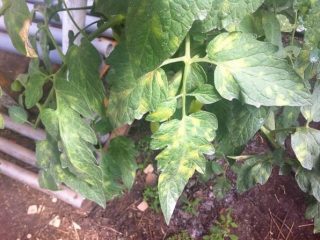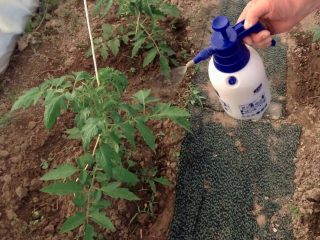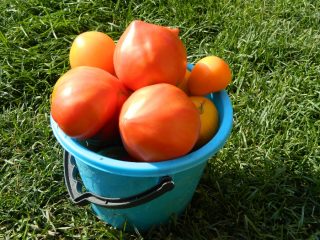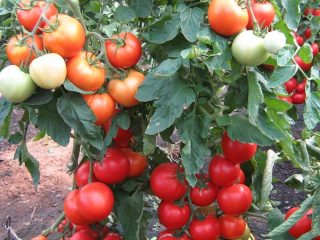Content
The Mammoth tomato is considered a standard in its shape and size. The harvest will please even the most demanding gardener. Among it there will be no fruits with unripe shoulders, gnarled, cracked or too small.
History of appearance
Breeders from Siberia often delight with new developments. The Mammoth variety is a new product from the agricultural company Seeds of Altai (2022). The originator emphasized endurance, high performance and productivity.

In containers for Mammoth tomato seedlings, drainage must be the first layer
Description of the tomato variety Mammoth with photo
The variety is universal, determinate, first generation hybrid (F1). Tolerates heat and cold very well. The fruits are large, slightly shaggy, somewhat reminiscent of a baby mammoth.
Features of the Mammoth tomato variety:
- dry stalk;
- does not require pinching;
- ease of care;
- absence of necrosis of the stem core;
- mid-early ripening period;
- after the formation of six fruit clusters, it stops growing in height;
- the bushes are low-growing, but with the yield of a tall hybrid.
Characteristics of the Mammoth tomato variety
In open ground, the bushes stretch to a maximum of 1.2 m, in closed ground - up to 1.5 m. The foliage is abundant, allowing the developing fruits to be protected from exposure to direct sunlight. Externally, the bush looks impressive and powerful.
Tomato fruits are average in weight - 150-170 g. Maximum weight - 250-400 g.
- Characteristics:
- slightly flattened round shape, the fruits look like apples;
- the skin is smooth, thin, but dense, bright red, glossy;
- the stalk is small;
- the flesh is fleshy, moderately juicy;
- the walls of tomatoes are thick;
- 4-6 seed chambers, with miniature seeds.
The taste of Mammoth tomatoes is moderately sweet, about 3 on a five-point scale, acidity – 1 point.

You can’t plant tomatoes in the same place year after year.
Ripening and yield of tomato Mammoth
Mammoth tomatoes ripen and form in a greenhouse and in open ground within 100-105 days from the moment of mass germination. All fruits are collected at one time, since they ripen at approximately the same time (mid-July). It takes five to seven days from browning to full maturity.
Important! Most of the fruit clusters are “hidden” under the foliage, so the seemingly small number of ovaries is a deceptive effect.
The weight of one brush is up to 2.5 kg. According to breeders, up to 15 kg of crop can be harvested from one bush.
Resistance to diseases and pests
Tomato Mammoth is rarely affected by pests and is quite resistant to most diseases. At the same time, it has low tolerance to brown spot and mosaic.
Growing regions
The variety is designed for cultivation in any region. It is perfectly adapted to cool climates and heat. Thanks to large leaves that do not curl even at +45 ° C, the fruits do not suffer from ultraviolet radiation. Tomatoes can be grown in open and closed ground.
Methods of application
The variety has a universal purpose. The fruits are equally good both fresh and after heat treatment. They can be canned, dried, dried, frozen. Make adjika, paste, ketchup and juice from the pulp.
Advantages and disadvantages
Tomatoes have a pleasant taste and aroma. They store well and ripen indoors.

You cannot thicken the planting of tomatoes, otherwise there will be a lack of oxygen, and, as a result, pests and diseases will appear
Pros:
- high productivity;
- ease of cultivation due to its small size;
- stress resistance to both temperature changes and drought;
- there are no restrictions on the geography of cultivation;
- ripen well in room conditions;
- do not require frequent fertilization and watering;
- there is an opportunity to collect your own seed material;
- high resistance to diseases and pests.
Minuses:
- complex clusters are formed with some flowers missing from the ovary;
- in one ovary there are fruits of different sizes.
Planting tomato Mammoth
The agricultural technology of the Mammoth tomato is standard. In March, seeds are planted in the soil, covered with peat and a soil layer of about 1 cm. Pre-sowing preparation is carried out in four stages:
- Calibration or screening out dummies. To do this, add a teaspoon of salt to a glass of warm water and pour the seeds into it for 20 minutes. Inappropriate material will float to the top. Good seeds are washed with water and dried.
- Disinfection or disinfection. It is carried out using a weak solution of potassium permanganate, into which the material is placed for 30 minutes.
- Stimulation or soaking of seeds for 10-12 hours in a growth stimulator. Zircon, Fitosporin, Epin are suitable for these purposes. The procedure is recommended for the second year when collecting seeds yourself.
- Soil preparation. It must be disinfected, breathable and lightweight. A universal substrate for seedlings is suitable.
Watering seedlings is done scatteredly. The crops are covered with film or glass and grown at a temperature of +25 °C. As soon as the first shoots appear, the shelter is removed and sent to a place where there is a lot of light. Carry out the hardening procedure. In the first 5-7 days, seedlings are kept at a temperature of 15-16 °C, then 20-22 °C.
After 1-2 leaves appear, the bushes dive. At about 60-65 days (May-June), the seedlings are planted in a permanent place. The main thing is that the crop has 6-7 leaves and at least one flower cluster.
Regardless of the type of soil, a distance of 40 cm is left between plants.

Transplantation of seedlings to a permanent place is carried out using the transshipment method.
Care instructions
Growing Mammoth tomatoes does not require a lot of water. After planting, water at the root for the first time after about 7-14 days. Then water 1-2 times for seven days.On average, one bush uses 5 liters. Watering is carried out at the root, preferably with warm water. To stop the rapid evaporation of moisture from the top of the soil, mulch with a layer of compost, pine needles and straw (5-6 cm).
Hilling is carried out two times:
- 14 days after planting in a permanent place;
- 14 days after the first hilling.
Mandatory garter is not required in open ground. However, the plant has large brushes, so there is always a risk that the stem will break. Therefore, even in the garden it is better to play it safe and install a peg at each bush.
Is it necessary and how to plant a Mammoth tomato?
There is no need to plant Mammoth tomatoes. When forming, only unnecessary branches are removed. And the complex type of fruit raceme does not allow all the flowers to set.
Is it necessary and how to form a Mammoth tomato?
Formation of the Mammoth tomato is required both in open and closed ground. It is recommended to form bushes in a greenhouse - 3-4 stems, in the garden - 1-2.

When ripening in room conditions, Mammoth does not lose its taste and aroma.
Pest and disease control
The variety has high immunity. To avoid the appearance of pests and late blight, it is recommended to treat with Phytosporin once (three weeks after planting in a permanent place).

Baby Mammoth fruits from one ovary have different weights and sizes
If the leaves of a tomato begin to lose their brightness and become lighter between the veins, most likely the plant does not have enough magnesium. The deficiency of the beneficial substance is replenished with a solution of magnesium sulfate: per 10 liters of water - 1 tbsp. l.Watering is carried out at the root with 2-3 liters of mixture.
Conclusion
Despite the fact that the Mammoth tomato is a new variety, we can already safely talk about its versatility and promise. Among the advantages are the absence of the need for pinching and resistance to weather conditions, as well as high yields in hot and cold climatic zones. This is a natural variety, hence tomato seeds are suitable for growing seedlings.
Reviews from gardeners about the Mammoth tomato












